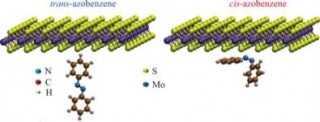Mar 1 2019
A number of technological applications, like the fabrication of extremely small optoelectronic devices, are increasingly using materials that are hybrid constructions (incorporating organic and inorganic precursors) and quasi-two-dimensional (with flexible and greatly compactable molecular structures).
 A structure comprising a molybdenum disulfide monolayer on an azobenzene substrate could be used to build a highly compactable and malleable quasi-two-dimensional transistor powered by light (Image credit: Atomistic representations of molybdenum disulfide monolayer with an azobenzene molecule in its trans and cis isomers/Physical Review B)
A structure comprising a molybdenum disulfide monolayer on an azobenzene substrate could be used to build a highly compactable and malleable quasi-two-dimensional transistor powered by light (Image credit: Atomistic representations of molybdenum disulfide monolayer with an azobenzene molecule in its trans and cis isomers/Physical Review B)
A study conducted in this field has featured in the journal Physical Review B. This study is based on the doctoral research of Diana Meneses Gustin and Luís Cabral, both guided by Victor Lopez Richard, a professor at the Federal University of São Carlos (UFSCar) in Brazil. Juarez Lopes Ferreira da Silva, a professor at the University of São Paulo’s São Carlos Chemistry Institute (IQSC-USP), co-supervised Cabral. FAPESP supported Gustin through a doctoral scholarship and a scholarship for a research internship abroad.
Gustin and Cabral explain theoretically the unique optical and transport properties resulting from interaction between a molybdenum disulfide monolayer [inorganic substance MoS2] and a substrate of azobenzene [organic substance C12H10N2].
Lopez Richard, Professor, Federal University of São Carlos
Illumination causes the azobenzene molecule to switch isomerization and change from a stable trans-spatial configuration to a metastable cis state, generating effects on the electron cloud in the molybdenum disulfide monolayer. The effects are reversible and were earlier investigated experimentally by Emanuela Margapoti as part of a postdoctoral research supported by FAPESP and conducted at UFSCar.
Gustin and Cabral together created a model to reproduce the process theoretically.
They performed ab initio simulations [computational simulations using only established science] and calculations based on density functional theory [a quantum mechanical method used to investigate the dynamics of many-body systems]. They also modeled the transport properties of the molybdenum disulfide monolayer when disturbed by variations in the azobenzene substrate.
Lopez Richard, Professor, Federal University of São Carlos.
Technological applications have not been addressed by the published paper; however, the deployment of the effect to create a light-activated two-dimensional transistor is still on the researchers’ agenda.
The quasi two-dimensional structure makes molybdenum disulfide as attractive as graphene in terms of space reduction and malleability, but it has virtues that potentially make it even better. It’s a semiconductor with similar electrical conductivity properties to graphene’s and it’s more versatile optically because it emits light in the wavelength range from infrared to the visible region.
Lopez Richard, Professor, Federal University of São Carlos.
Even though the hybrid molybdenum-disulfide-azobenzene structure is treated to be a material that is greatly promising, a lot of effort is needed on the research and development part if this material needs to be efficiently deployed in useful devices.